Friday, April 2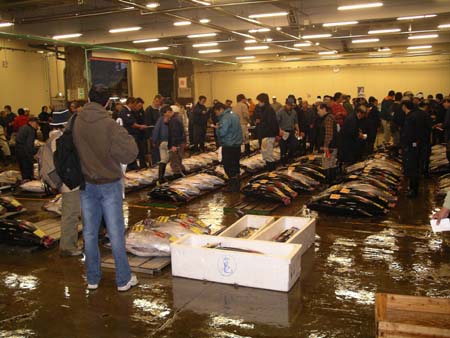
Steve and Paula: Our day started at 4:15AM with a wake-up call that was timed to allow us to arrive at Tokyo's famous Tsukiji fish market for the daily 5:00AM tuna auction. We had heard and read that this was a "must-see" in Tokyo, but our bodies clearly objected to this early rising (especially with us all trying to get over colds). Fortunately, we quickly found that the sacrifice was well worth it…
 Tsukiji
is Tokyo's primary source for all seafood, and is the by far the largest and
most impressive fish market that we've seen anywhere. Nothing else comes close.
Tsukiji
is Tokyo's primary source for all seafood, and is the by far the largest and
most impressive fish market that we've seen anywhere. Nothing else comes close.
We arrived in the rain just after 5AM, being left off by a taxi in an area
that turned out to still be quite a walk from the actual market (taxis here
are unbelievably expensive - the 15-minute ride ran $32 and was necessitated
by the fact that the  subways
don't start until 5:30AM). After weaving our way among small seafood and produce
shops, we finally found ourselves in a mammoth seafood warehouse, teeming
with forklifts and motorized carts buzzing in all directions. We'd come back
to explore the fish market later, but our first order of business was finding
the tuna auction.
subways
don't start until 5:30AM). After weaving our way among small seafood and produce
shops, we finally found ourselves in a mammoth seafood warehouse, teeming
with forklifts and motorized carts buzzing in all directions. We'd come back
to explore the fish market later, but our first order of business was finding
the tuna auction.
 After
asking directions many times (with the help of a Japanese/American woman who
speaks Japanese and was looking for the same thing), we found ourselves in
a huge room with probably 300 large tunas arranged neatly rows on the floor.
The room was packed, both with suppliers who were busy inspecting the fish
with hooks and flashlights, and also other visitors who gawked along with
us at the amazing sight.
After
asking directions many times (with the help of a Japanese/American woman who
speaks Japanese and was looking for the same thing), we found ourselves in
a huge room with probably 300 large tunas arranged neatly rows on the floor.
The room was packed, both with suppliers who were busy inspecting the fish
with hooks and flashlights, and also other visitors who gawked along with
us at the amazing sight.
The tuna ranged in size, but all appeared to weigh at least 100 pounds with
the largest weighing over 520 pounds. At an average auction price of $25/pound
(an estimate that was provided to us), this fish was auctioned for over $13,000.
Of course, by the time it gets to a restaurant table, the price per pound
will be much higher…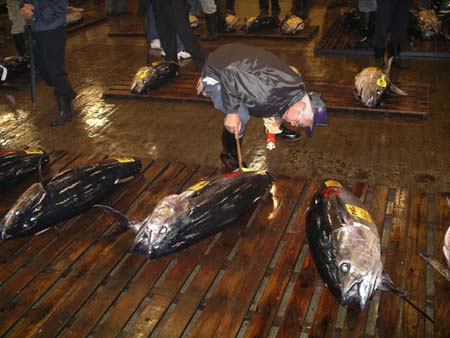
The fish we saw today had been caught all over the world. They included catches
from Australia, Malaysia, Guam, Vietnam, Japan, Sri Lanka and even Maine.
These fish are immediately flash-frozen, placed on planes, and arrive here
in Tokyo generally within 2 days of being caught. There are seven main wholesalers
who purchase the fish from the fishermen and then auction them off during
this daily process. By the time the fish have been arranged in the auction
room and the suppliers all arrive for  the
inspection process, they've all been thawed and are ready to be prepared for
resale.
the
inspection process, they've all been thawed and are ready to be prepared for
resale.
We arrived in the middle of the fish inspection process, and watched as the
"jobbers" (the suppliers who buy the fish and then in turn sell
it to restaurants and stores) assessed the quality of each fish. They poked
and prodded (using hooks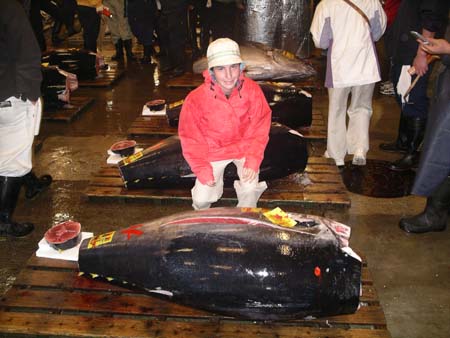 and flashlights) each fish in various places, and also took small samples
of meat that they rolled between their fingers and also tasted it in order
to determine the value of each specimen.
and flashlights) each fish in various places, and also took small samples
of meat that they rolled between their fingers and also tasted it in order
to determine the value of each specimen.
At 5:30, bells started ringing to indicate the start of the auction process.
Right on queue, several auctioneers positioned at various spots each began
the bidding process. Each auctioneer had his own style, some conducting the
process in loud and often humorous tones (including interesting gyrations
of legs and arms). As they called out various prices, suppliers gave hand
signals indicating their willingness to stay in the bidding at each subseq uently
higher price. The bidding for each fish was completed very quickly - usually
in 30 seconds or less - and the auctioneer moved purposefully on to the next
fish. When all the fi
uently
higher price. The bidding for each fish was completed very quickly - usually
in 30 seconds or less - and the auctioneer moved purposefully on to the next
fish. When all the fi sh
in an area of the room were sold, the auctioneer would move to another section
with his bell, suppliers would gather around, and the process would start
all over again.
sh
in an area of the room were sold, the auctioneer would move to another section
with his bell, suppliers would gather around, and the process would start
all over again.
Finally, when all the fish had been auctioned, the suppliers moved in with huge carts, and the fish were hauled into the adjacent market to be prepared for resale. What an amazing scene this all was!!!
 After
the auction, we walked through the actual fish market, having to dodge the
endless forklifts that buzzed down the aisles. Wherever we went, we always
felt like we were in the way of the suppliers and their customers (restaurants
After
the auction, we walked through the actual fish market, having to dodge the
endless forklifts that buzzed down the aisles. Wherever we went, we always
felt like we were in the way of the suppliers and their customers (restaurants
 and stores) who were negotiating and making their purchases, then quickly
transporting their hauls to trucks waiting outside. The market is filled with
an endless variety of fish and shellfish, including several varieties that
we have not seen before. Octopus was a common sight, as were giant scallops
and of course the tuna that had just been purchased in the auction and now
was
and stores) who were negotiating and making their purchases, then quickly
transporting their hauls to trucks waiting outside. The market is filled with
an endless variety of fish and shellfish, including several varieties that
we have not seen before. Octopus was a common sight, as were giant scallops
and of course the tuna that had just been purchased in the auction and now
was  being
carefully cut and prepared. We walked up and down several aisles, amazed at
the sheer quantity of seafood that would all be sold today. Finally, especially
with things getting busier and more crowded, we decided to head back to the
hotel (this
being
carefully cut and prepared. We walked up and down several aisles, amazed at
the sheer quantity of seafood that would all be sold today. Finally, especially
with things getting busier and more crowded, we decided to head back to the
hotel (this 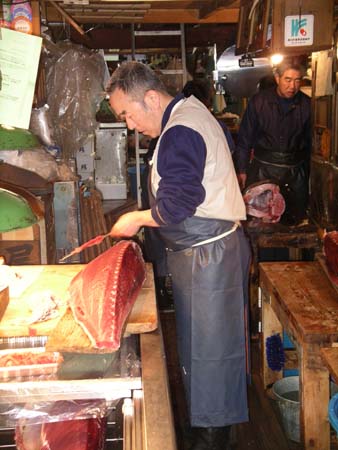 time
by subway…).
time
by subway…).
We decided that we had earned the right for additional sleep, and all took
naps until late morning. Awaking hungry and inspired from our morning of seafood,
we decided that sushi was in order for today's lunch. We found a perfect spot
close to the hotel, displaying several sushi platters in plastic form outside
the  restaurant.
We have noticed this is a very common way to advertise for restaurants here
and the plastic foods actually look very realistic.
restaurant.
We have noticed this is a very common way to advertise for restaurants here
and the plastic foods actually look very realistic.
As we entered the establishment all the waiters yelled out a traditional
Japanese greeting and we were ushered to our table. There was only one other
Westerner in the restaurant, (always a good sign) and he was a businessman
sitting with Japanese colleagues. After serving us green tea, the waitress showed us the menu. Since it was all written in Japanese, we
just pointed at plates of food at the tables next to us.
the waitress showed us the menu. Since it was all written in Japanese, we
just pointed at plates of food at the tables next to us.
 When
we received our plates, each one had 11 sushi selections all beautifully arranged.
We were only able to identify the tuna and shrimp - therefore, most of our
lunch today was simply raw fish of unknown variety. We did find out that one
of the items was eel, and we're pretty sure that
When
we received our plates, each one had 11 sushi selections all beautifully arranged.
We were only able to identify the tuna and shrimp - therefore, most of our
lunch today was simply raw fish of unknown variety. We did find out that one
of the items was eel, and we're pretty sure that  there
was salmon and swordfish in the mix. We couldn't identify one particularly
chewy fish, and really didn't want to know what it was. Steve and David ate
their caviar, but Paula and Katie only ventured a small taste. All-in-all,
this was a very fun experience, and we enjoyed watching all the people in
the restaurant taking note of us and smiling (apparently not too many Western
families with children frequent this place…).
there
was salmon and swordfish in the mix. We couldn't identify one particularly
chewy fish, and really didn't want to know what it was. Steve and David ate
their caviar, but Paula and Katie only ventured a small taste. All-in-all,
this was a very fun experience, and we enjoyed watching all the people in
the restaurant taking note of us and smiling (apparently not too many Western
families with children frequent this place…).
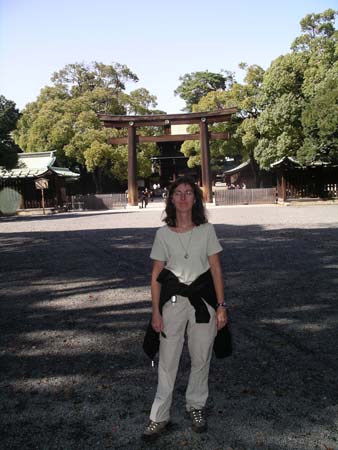 The
area of Aoyama was the next neighborhood we chose to explore. After arriving
by local train, we found the area hoping with teenagers all shopping. We weren't
up for much shopping and instead spent an hour walking through another lovely
park, Meiji-Jingu. A shrine in the middle of the park is dedicated to Emperor
Meiji and Empress Shoken and was originally built in 1920. It was destroyed
during World War II and then rebuilt in 1958. The huge gates are made from
cypress trees and are just beautiful. The temple is also quite pretty
The
area of Aoyama was the next neighborhood we chose to explore. After arriving
by local train, we found the area hoping with teenagers all shopping. We weren't
up for much shopping and instead spent an hour walking through another lovely
park, Meiji-Jingu. A shrine in the middle of the park is dedicated to Emperor
Meiji and Empress Shoken and was originally built in 1920. It was destroyed
during World War II and then rebuilt in 1958. The huge gates are made from
cypress trees and are just beautiful. The temple is also quite pretty and we spent a few moments to reflect and write our own special wishes and
prayers to be hung on a large tree, called the "Divine Tree."
and we spent a few moments to reflect and write our own special wishes and
prayers to be hung on a large tree, called the "Divine Tree."
 Before
heading back toward our hotel, we made our way to the Sony Building in Tokyo's
Ginza area to check out their latest products including some that have not
yet been released. We were particularly amazed at the small cameras and camcorders.
David and Katie had fun playing with some of the virtual reality games including
one called "Eye Play." We have been amazed by the number of people
here who incorporate technology into their daily lives. Everywhere you
Before
heading back toward our hotel, we made our way to the Sony Building in Tokyo's
Ginza area to check out their latest products including some that have not
yet been released. We were particularly amazed at the small cameras and camcorders.
David and Katie had fun playing with some of the virtual reality games including
one called "Eye Play." We have been amazed by the number of people
here who incorporate technology into their daily lives. Everywhere you  look
there are electronic stores and street displays with the most recent technology.
This seems to be especially true with mobile phones. Not only does everyone
have a mobile phone, but they use them for
look
there are electronic stores and street displays with the most recent technology.
This seems to be especially true with mobile phones. Not only does everyone
have a mobile phone, but they use them for  much
more than communication. We constantly see people using the internet on their
phones, using instant messenger services, taking pictures, etc. The penetration
of hand-held internet devices in Japan is huge compared with any other place
in the world.
much
more than communication. We constantly see people using the internet on their
phones, using instant messenger services, taking pictures, etc. The penetration
of hand-held internet devices in Japan is huge compared with any other place
in the world.
It has been exciting to be in a large, thriving modern metropolis again for
a few days. Tokyo has amazed us in many ways - it's extremely active, yet
unbelievably clean and quiet. It's certainly quite a contrast from the other
large Asian cities we've visited. Katie's entry today provides a good overview
of several of our observations. Additionally, the spring weather has also
been welcoming and we are hoping to view more cherry blossoms as we head to
Kyoto tomorrow.
Katie's Kwick Kwacks: My Impressions of Tokyo. During our stay here
in Tokyo, the largest city in the world, we have experienced a major culture
shock. The next paragraph describes some of my observations of this city and
how they are different from what we have seen in other countries in Asia.
- The city is extremely clean and there are many trash cans and recycling
bins (you would never believe that 8.5 million people live in the city - with
30 million in the greater metropolitan area)
- Most of the people are in business suits, and everyone is serious and quiet
- There are strict regulations for where you can and can't smoke
- There are many street maps and signs-they all look brand new and clear
- There are many toilet facilities around the city, and they are all remarkably
clean, high-tech, and western
- TECHNOLOGY!
- All the people are carrying fancy cell phones that take pictures, have many
games, and connect to the internet-everyone on the subway is either reading
or playing with their cell phone
- Most restaurants, big and small, have electronic devices to take food orders
with
- Every single building looks brand new and is fully painted
- Similar to New York City, Tokyo is filled with lines of sky scrapers and
lit up advertisements.
- Between every few stores there is a type of gadget or technology-related
company
- Everyone is busy and rushing to get to work-the subway stations are always
full from 5 AM to 8 PM.
- The subway stations are very clean and the ticket machines are high-tech.
Inside the trains of the subways there are electronic blinking signs, clear
maps, and boards telling the passengers the distance between stations etc.
- There is no graffiti on the walls and everyone is silent and stern.
- The entire city has a steady crispness to it and the people walk very purposefully.
- There are no car horns!!!
- All of the streets are marked clearly and there are freshly painted bike
lanes and pedestrian walkways everywhere
- The city is very pedestrian friendly, and there are many public fountains,
parks, and gardens
- All of the buildings are packed and the entire city seems jammed into a
wide valley
As you can see, Tokyo is very different from any other city we have visited on our trip in Asia. We hope that as we continue to explore cities here in Japan we will be able to compare them to this one, and build on our understanding of the country itself.

David's Daily Dump: The Tokyo Fish Market. Today we visited the largest and most spectacular fish market on earth: The Tsukiji Tokyo Fish Market. We woke up at 4:15 in the morning to see for ourselves this massive market and its famous tuna auction.
As we caught our first glimpse of the tuna auction through the pouring rain we could hardly believe our eyes. There lying on huge wooden platforms were hundreds and hundreds of blue-fin tuna from all corners of the globe, being auctioned off to wholesalers at rapid pace. We stood there in awe watching the events of the busy morning unfold…
The first thing that we saw was all the suppliers scanning the rows of fish the best sale. They all walked around with big hooks, flashlights, paper and pencils testing all the tuna for quality. Each tuna (ranging from 100 to over 500 pounds!!) had its tail and guts cut out with big slits in their bellies. The suppliers would lift the tuna up with their hooks and stick their flashlights in the slit checking the color of the flesh. Then they would take a pinch of the meat off the tail, smell it, squeeze it in between their fingers and finally taste it. It they liked the fish they would right down its number (each fish had a number painted on its side) and try to get it during the auction.
The suppliers also consider where the fish was caught (we saw fish from the U.S, Guam, Sri Lanka, Australia, and Japan) and the size of the fish. Supposedly the fish tastes different depending on which part of the world it was caught. This procedure lasted from about 5:00 to 5:30; that's when the real fun began…
The Auction: the most exciting part of the morning. At around 5:35 in the morning, bells started ringing and came from almost every direction as the suppliers rushed towards their favorite fish of the day. Each auctioneer had his own chant and way of selling. They have to sell all the fish in half an hour, so each person must have their own rapid style. Each buyer who wished to stay in the running waved his hand responding to each shout. After about thirty seconds someone would win the fish and cart it away to his stall in the market preparing it for shipment to sushi bars throughout Tokyo. When one fish was done, the auctioneer would wipe the sweat from his forehead, run to the rest of his tuna, ring the bell and start all over.
It was neat hearing all the different chants and seeing hand after hand shooting
up into the air waving frantically trying to catch the wholesaler's attention.
After about fifteen minutes of auctioning, shouting, and bargaining almost
all the tuna were on carts headed for the fish market. We walked through this
incredible market and saw the huge tuna being cut and packaged for the restaurants.
This was a truly incredible experience.
You might be thinking right now, "How do all these tuna get to Japan from all over the world in less than three days?" Well, the story of tuna # 69 (the first tuna visible in this picture) starts a little something like this…Tuna 69 is caught off the shores of Maine while looking for a meal and brought directly to the dock where he is sold to a Japanese trading company. Before boarding the cargo jet he is frozen at negative 76 degrees and gutted. Then number 69 is flown halfway around the world to Tokyo where he is driven to the fish market. There he is unloaded and sold to yet another supplier. Once with the supplier he is chopped up into two piles: edible and non-edible. Once cut into many pieces his right side is sold to the Keio Plaza Sushi bar while his left side and lower body is sold to the Shinjuku Restaurant before becoming supper. Finally our friend, tuna number 69, is made into sushi while hungry Japanese pay five dollars for every bite of his tasty raw flesh! In the end, our friend ended up passing through about seven companies each making a lot of money.
This market was plain old awesome!!! I absolutely loved seeing those huge tuna lined up on the floor, hearing the chants of auctioneers, and seeing all the weird fish in the market. It was an experience that I will never ever forget.
